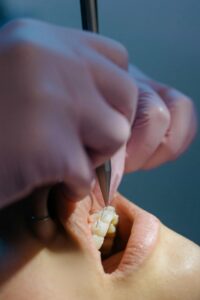Ever looked in the mirror and noticed your bottom teeth jutting out in front of your top ones?
That’s an underbite, and while it might make you feel a bit like a bulldog, it’s a common dental issue that many people face. But don’t worry—there’s a fix for that, and it doesn’t involve learning to love dog biscuits.
Underbites can cause more than just a quirky smile; they can lead to real oral health problems and affect your daily life. From difficulties in chewing and speaking to potential jaw pain, an underbite is more than just an aesthetic concern.
At A Winning Smile Orthodontics, we get it—dealing with dental issues can be a pain, literally and figuratively. That’s why we’re here to help. Whether you’re curious about the effectiveness of braces for underbites or looking for a personalized treatment plan, we’ve got the expertise to guide you through it.
In this article, we’ll dive into how braces can fix an underbite, what the treatment process looks like, and why choosing the right orthodontic care is crucial for a winning smile.
Understanding Underbites
So, what exactly is an underbite? Picture this: your lower teeth sit in front of your upper teeth when your mouth is closed, giving your smile a bit of a reversed look.
This is known as a Class III malocclusion. While some might think it adds character, an underbite can bring along a host of challenges.
What Causes an Underbite?
Underbites can be traced back to a mix of genetic and environmental factors. If you inherited your dad’s strong jawline or your mom’s tooth alignment, you might also have picked up their underbite tendencies. Genetics play a significant role in jaw and teeth alignment, making underbites a family affair.
But it’s not all down to your DNA. Childhood habits like thumb sucking, prolonged pacifier use, or even certain tongue-thrusting behaviors can influence the development of an underbite. Sometimes, the early loss of baby teeth or improper growth of adult teeth can also lead to this condition.
Why Should You Address an Underbite?
Ignoring an underbite isn’t just about living with a quirky smile; it can lead to real oral health issues. Here are a few reasons why addressing an underbite is important:
- Chewing and Speaking Difficulties: An underbite can make it hard to chew food properly or even speak clearly, turning everyday activities into frustrating tasks.
- Jaw Pain and TMJ Disorders: Misaligned teeth can strain your jaw muscles, leading to chronic pain and conditions like Temporomandibular Joint (TMJ) disorders.
- Tooth Wear and Damage: When your teeth don’t align correctly, they can wear down unevenly or even crack over time, leading to further dental complications.
- Gum Disease and Tooth Decay: Crowded and misaligned teeth are harder to clean effectively, increasing the risk of gum disease and cavities.
Understanding the root causes and potential issues related to underbites is the first step toward taking action. Addressing an underbite not only enhances your smile but also improves your overall oral health, setting the stage for a lifetime of confident, pain-free living.
Can Braces Fix an Underbite?
You might be wondering, “Can braces fix an underbite?” The short answer is yes! Braces are a highly effective treatment for correcting underbites, and they come with various options to suit different needs and preferences.
How Braces Work for Underbites
Braces work by applying continuous pressure over time to gradually move teeth into their proper positions. For underbites, this means shifting the lower teeth back, moving the upper teeth forward, or sometimes a combination of both.
The goal is to align the bite so that the upper teeth sit comfortably over the lower teeth.
Types of Braces for Underbites
There are several types of braces that can be used to correct an underbite:
- Traditional Metal Braces
- Ceramic Braces
- Invisalign
Treatment Process for Underbites
Embarking on the journey to correct an underbite with braces involves a well-structured treatment process designed to ensure effective and lasting results.
Here’s a detailed look at what you can expect during the treatment process:
Initial Consultation
The first step in treating an underbite is an initial consultation with your orthodontist. During this visit, the orthodontist will:
- Examine your teeth and jaw: A thorough examination helps assess the severity of the underbite.
- Take X-rays and impressions: These provide a detailed view of your teeth and jaw structure, which is essential for developing a precise treatment plan.
- Discuss treatment options: Based on the examination, your orthodontist will recommend the best type of braces for your underbite, whether traditional metal braces, ceramic braces, or Invisalign.
Placement of Braces
Once a treatment plan is in place, it’s time to apply the braces. Here’s what happens:
- Cleaning and preparation: Your teeth will be cleaned and prepared for the brackets.
- Attaching brackets: Brackets are bonded to each tooth using a special adhesive.
- Inserting the archwire: A wire is threaded through the brackets, which will guide the movement of your teeth over time.
- Initial adjustments: The orthodontist will make initial adjustments to ensure the braces start working effectively from day one.
For those using Invisalign, you’ll receive your first set of custom-made aligners during this visit.
Regular Adjustments
Braces work by applying continuous pressure to move teeth into their desired positions. To ensure this process stays on track, regular adjustments are necessary:
- Monthly check-ups: Typically, you’ll visit your orthodontist every 4-6 weeks.
- Tightening wires: For traditional braces, the orthodontist will tighten the wires and possibly replace them to maintain the right amount of pressure.
- New aligners: For Invisalign, you’ll receive a new set of aligners approximately every two weeks to continue the gradual adjustment of your teeth.
- Progress monitoring: These visits allow the orthodontist to monitor progress and make any necessary adjustments to the treatment plan.
Managing Discomfort and Care
Adjustments can cause some discomfort, but this is usually manageable:
- Pain relief: Over-the-counter pain relievers can help ease any soreness after adjustments.
- Orthodontic wax: Applying wax can protect your mouth from irritation caused by brackets or wires.
- Dietary changes: You might need to avoid hard, sticky, or chewy foods that can damage your braces.
Final Adjustments and Retention
Once your teeth have moved into their correct positions and the underbite is corrected, the final stage involves removing the braces:
- Braces removal: The orthodontist will carefully remove the brackets and wires, clean your teeth, and possibly take final X-rays or impressions.
- Retention: To prevent your teeth from shifting back, you’ll need to wear a retainer. Retainers can be removable or fixed, depending on your specific needs.
- Follow-up visits: Regular follow-up visits ensure your teeth stay in their new positions and that the results are long-lasting.
With dedication and the right treatment plan, correcting an underbite with braces can lead to a healthier, more confident smile.
A Winning Smile Orthodontics’ Approach
At A Winning Smile Orthodontics, we believe that every smile is unique and deserves personalized care. Treating an underbite requires a blend of expertise, advanced technology, and a patient-centered approach. Here’s how we ensure our patients receive the best possible care for their underbite correction.
Comprehensive Initial Consultation
Our journey together begins with a thorough initial consultation.
During this visit, we:
- Conduct a detailed examination: Using state-of-the-art imaging technology, we take comprehensive X-rays and impressions of your teeth and jaw. This helps us understand the full scope of your underbite and plan an effective treatment strategy.
- Discuss your goals: We listen to your concerns and treatment goals, ensuring that we align our approach with your expectations.
- Develop a customized treatment plan: Based on the examination and your preferences, we recommend the best treatment options, whether it’s traditional braces, ceramic braces, or Invisalign.
Personalized Treatment Plans
No two underbites are the same, which is why we tailor our treatment plans to meet the specific needs of each patient.
Our personalized approach includes:
- Regular progress reviews: We schedule regular check-ups to monitor your progress and make any necessary adjustments. This ensures that your treatment stays on track and adapts to any changes in your dental structure.
- Patient education: We believe in empowering our patients with knowledge. Throughout your treatment, we provide detailed instructions on caring for your braces, managing discomfort, and maintaining oral hygiene.
Advanced Technology and Techniques
At A Winning Smile Orthodontics, we leverage the latest advancements in orthodontic technology to enhance our treatment effectiveness and patient comfort.
Our approach includes:
- 3D Imaging and Digital Scans: These tools allow for precise planning and visualization of your treatment, ensuring optimal results.
- High-quality materials: We use the best materials for braces and aligners, providing durability and comfort throughout your treatment.
- Innovative techniques: Our orthodontists stay updated with the latest industry advancements to offer cutting-edge solutions for underbite correction.
Commitment to Patient Comfort and Satisfaction
We understand that orthodontic treatment can be daunting, which is why we prioritize patient comfort and satisfaction at every step.
Our commitment includes:
- Comfortable environment: Our clinic is designed to be welcoming and comfortable, helping you feel at ease during your visits.
- Compassionate care: Our team is dedicated to providing friendly, compassionate care, addressing your concerns, and ensuring a positive treatment experience.
- Flexibility and convenience: We offer flexible scheduling and are always available to address any emergencies or urgent concerns you might have during your treatment.
At A Winning Smile Orthodontics, our approach to treating underbites is comprehensive, patient-focused, and rooted in a commitment to excellence. We’re here to guide you through every step of your orthodontic journey, ensuring that you achieve a healthy, confident smile that lasts a lifetime. If you’re ready to explore your treatment options, contact us today to schedule your initial consultation.
Conclusion
Correcting an underbite isn’t just about achieving a more aesthetically pleasing smile—it’s about improving your overall oral health and quality of life. With the right treatment plan, braces can effectively fix an underbite, addressing issues like chewing difficulties, jaw pain, and uneven tooth wear.
The journey to a healthier, more confident smile starts with understanding your treatment options and choosing an orthodontic practice that prioritizes your well-being. At A Winning Smile Orthodontics, we’re here to support you every step of the way, ensuring your orthodontic journey is as smooth and successful as possible.
So, can braces fix an underbite? Absolutely. With the right approach and a dedicated team by your side, achieving a beautifully aligned smile is well within reach!





